Press brakes are especially dangerous pieces of machinery that require operator caution, regular maintenance, and protective safeguards. Used extensively in the forming of sheet metal and plate materials, press brakes are a frequent cause of amputations and crushing injuries.
Because of this danger, press brakes are currently a hot topic in the machine safeguarding arena. OSHA regulations consider press brakes to be a 1910.212 machine, stating "one or more methods of machine guarding shall be provided to protect the operator and other employees in the machine area from hazards such as those created by point of operation, in-going nip points, rotating parts, flying chips, and sparks".
"The 1910.212 requirements are a good place to start, but what is left out are the details of exactly how to go about safeguarding particular machines; therefore, a reference to an ANSI Standard like B11.3 on press brakes is often used to identify specific safeguarding alternatives," explained Matt Brenner, Vice President of Sales for Rockford Systems, a provider of machine safeguarding solutions. "However, ANSI B11.3 may require additional references from ANSI B11.19 on safeguarding methods to provide a complete picture of how to go about protecting press brake operators."
Safeguarding methods
Press brakes manufactured before the mid-1980's were largely mechanical flywheel-type machines, many of which are still in use today. Because the stopping times on mechanical press brakes are long, equally long light curtain safety-distances result, making that safeguarding device impractical in many cases. Press brakes manufactured after the mid-1980's are more likely to be hydraulic. Hydraulic press brakes allow for a wider variety of safeguarding options than mechanical press brakes do, and offer faster stopping-times, resulting in closer safety-distances where light curtains or two-hand controls are used. Hydraulic press brakes for a light curtain can be mounted relatively close to the dies.
Two-hand controls on press brakes are often used in the sequence-mode of operation where the actuators bring the machine down and stop before the dies close, allowing just enough die-space to feed the part. The part is placed in the remaining die-opening, then a foot-switch is used to make the bend and return the machine to its full-open position.
Safety distance is required for both light curtains, and two-hand controls. That distance must be calculated with a stop-time measurement (STM) device on a quarterly basis. STM readings must be documented to show safety inspectors.
ANSI B11.3, which was updated in 2012, offers two completely new categories of protection for hydraulic press brakes: Active Optical Protective Devices (lasers) and Safe Speed Safeguarding. Active Optical Protective Devices (AOPDs) detect hands and fingers in a danger area. The biggest attraction for AOPDs are for jobs where the operator must hand hold small parts up close to the dies. A unique feature of AOPDs is that that they are designed to be mounted with zero safety distance, unlike light curtains that must be mounted at a calculated safety-distance, as outlined in ANSI B11.3. Safe Speed Safeguarding is based on a ram speed of 10mm per second or less, providing that speed is carefully monitored. Again, these two new methods of protection can only be applied to hydraulic press brakes and potentially, Servo-Drive Press Brakes.
Other hazards
The backs of press brakes cannot be left wide open. Two hazards exist often exist here. The first is reaching the dies from the back, while the second is the possibility of a multi-axis back gauge moving and creating pinch points. As to exactly what is required on the back of equipment often depends on local OSHA interpretation. The very least, an awareness barrier, like a railing, chain, or cable with a "Warning" sign, complete with Pictograms, not just verbiage. For local OSHA interpretations that won't accept awareness barriers, a full perimeter guard may be the answer for the back of a press brake. That guard can either be bolted into position, or if it's movable, an electrical interlock switch can be installed to make sure it stays closed.
As with any industrial machine, Lockout/Tagout on Press Brakes must strive for "Zero Energy State" to and within each piece of equipment using both locks and tags.
For more information, please visit www.rockfordsystems.com.
About Rockford Systems
Headquartered in Rockford, Illinois, Rockford Systems, LLC delivers innovative machine safeguarding solutions for organizations working with industrial machinery. As a trusted adviser since 1971, Rockford Systems helps organizations interpret and apply complex Occupational Safety and Health Administration (OSHA) regulations and American National Standards Institute (ANSI) machine safety standards for a broad array of industrial applications. In addition, Rockford Systems provides complete Safety Life-Cycle Management Solutions, including on-site surveys, customized engineering integration, over 10,000 safeguarding products, expert installation services, training and technical support, and ongoing compliance validation. Rockford Systems has improved the profitability of many of North America's largest companies by increasing compliance, reducing worker risk, enhancing productivity and decreasing costs.







